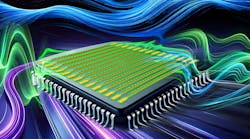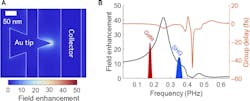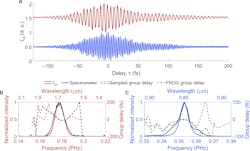Plasmonic Nanoantennas Implement Lightwave/Electronic Mixers
What you’ll learn:
- Why electrical circuits operating at optical frequencies is an attractive opportunity.
- How a new plasmonic arrangement is used to mix electrical signals at optical frequencies.
- The advantages and results of the mixing approach.
Engineers are fully aware of the practical gap between electronic-energy signals (RF) extending to the terahertz region versus energy in the optical region, which begins at the high end of terahertz zone. This schism exists, though both are part of electromagnetic (EM) spectrum and governed by the same fundamental principles and equations.
Researchers are trying to blur that distinctive split. Doing so would open the path to new ways to use the EM spectrum and ease development of electro-optic components and devices.
Lightwave electronics, also called petahertz electronics, is an emerging field that aims to integrate optical and electronic systems at incredibly high speeds, leveraging the ultra-fast domain of light’s energy fields. The key idea is to harness the electric field of lightwaves, which oscillate on sub-femtosecond (10-15 seconds) timescales, to directly drive electronic processes.
MIT’s Plasmonic Petahertz-Frequency Mixer
A team at MIT has developed a mixer frequency that goes far beyond gigahertz and even terahertz regions by reaching into the petahertz (PHz) range, corresponding to the frequencies of light waves.
Petahertz-frequency mixers would allow for shifting of signals up to optical frequencies and then back down to more conventional electronic frequencies. This enables the transmission and processing of vastly larger amounts of information at multiple orders-of-magnitude higher speeds. (While we usually characterize light in terms of wavelengths, using frequency is entirely valid and fully makes sense here.)
The MIT team’s demonstration of a plasmonic lightwave/electronic mixer at petahertz-scale frequencies is an important step toward making communication technology faster. It advances research toward developing new, miniaturized electronic circuitry capable of handling optical signals directly at nanoscale dimensions.
(Informally, plasmonics is the use of subwavelength structures to control the propagation of light. More formally, it’s the generation, detection, and manipulation of signals at optical frequencies along metal-dielectric interfaces in the nanometer scale.)
The goal is to bring “electronics” to the optical range of the EM spectrum. This isn’t a new goal, of course: In the 1970s, researchers began exploring ways to extend electronic frequency mixing into the terahertz range using diodes, and while these early efforts showed promise, progress has been slow in subsequent decades.
Leveraging Nanoantennas for Light-Frequency Mixing
However, recent advances in nanotechnology have reignited this area of research. Researchers discovered that tiny structures such as nanometer-length-scale needle tips and plasmonic antennas could function similarly to those early diodes, but at much higher frequencies.
The MIT team developed an electronic frequency mixer for signal detection that operates beyond 0.350 PHz using tiny nanoantennas. These nanoantennas can mix different frequencies of light, enabling analysis of signals oscillating orders of magnitude faster than the fastest accessible to conventional electronics.
While optical frequency mixing is possible using nonlinear materials, that process is purely optical (that is, it converts light input to light output at a new frequency). Furthermore, the materials must be many wavelengths in thickness, thus limiting the device size to the micrometer (millionth of a meter) scale.
In contrast, the lightwave/electronic method demonstrated by the authors uses a light-driven tunneling mechanism that offers high nonlinearities for frequency mixing and direct electronic output using nanometer (billionth of a meter) devices.
The work is supported by intense solid-state and optical-physics principles, with complex equations as well as materials insights. In a simplified description, they used a perturbative method that starts with a strong gate waveform driving sub-cycle photoelectron emission (Fig. 1).
A weak signal with the same polarization as the gate pulse then perturbs the photoemission response with the same polarization as the gate pulse. Subsequently, the photoemission response is perturbed as a function of delay τ. (They also acknowledge that there’s an alternative to their perturbative method called the streaking-like method, and they explain why it wasn’t used.)
The delay-dependent current relates directly to the signal’s electric field through an instantaneous coupling between the signal and gate waveforms. It’s analogous to the coupling of voltage waveforms in nonlinear electronic frequency mixers.
They used an asymmetric nanoantenna design, which naturally breaks inversion symmetry and enables the frequency response to have both even and odd integer harmonics (Fig. 2). Gold was used as the antenna material and fused silica as the substrate.
The nominal nanoantenna geometry was chosen to have a resonant frequency between that of the fundamental and second harmonic for two reasons. First, it represents a compromise where the fundamental and second harmonic both have maximal field enhancement. Second, because the fundamental and second harmonic both excite the antennas off-resonance, they experience a negligible amount of intensity reshaping and group delay dispersion.
Testing the Spectral Intensity
After first confirming their arrangement was actually operating in an optical-field emission regime, they illuminated the antennas with a gate pulse (Fig. 3). Along with many other assessments, they measured the spectral intensity using a commercial grating-based indium-gallium-arsenide spectrometer.
They concluded that their harmonic frequency mixing process enables accurate readout of optical signal waveforms spanning more than one octave of bandwidth. In contrast to wave mixing in crystals, this optical field-driven tunneling mechanism provides access to higher-order nonlinearities, and thus larger mixing bandwidths. It eliminates the need for phase-matching or a separate photodetection element, in addition to offering other arrangement and measurement benefits.
This exposition can only touch on the subtleties of their work, which was supported by a list of government and commercial grants. Their project is detailed paper that, despite its technical intensity, has a crisp and direct title “Lightwave-electronic harmonic frequency mixing” published in Science Advances.

![1. Schematic of experimental measurement: (A) A gate pulse illuminates the nanoantenna network and drives sub-optical cycle electron emission. A small signal is introduced over a variable delay. This small signal modulates the electron emission from the nanoantennas, leading to the optical-frequency mixing process. Both the gate and signal pulse polarization are parallel to the nanoantenna tip axis as indicated by the black arrow. (B) A representative scanning electron microscope image showing the nanoantennas and the polarization incident on the nanoantennas. (C) The devices can be conceptualized as electronic harmonic frequency mixers (top schematic) with the gate waveform of central frequency fgate serving as the local oscillator (LO, with central frequency fLO = fgate), and the signal having central frequency fsignal as the optical frequency input (OF, with central frequency fOF = fsignal). The mixing process (bottom schematic) provides a current signal at baseband [intermediate frequency (IF)] for the detection of harmonics of the local oscillator kfLO (right plot). Here, they measure the baseband response for field-resolved measurement of the signal as a function of delay τ. 1. Schematic of experimental measurement: (A) A gate pulse illuminates the nanoantenna network and drives sub-optical cycle electron emission. A small signal is introduced over a variable delay. This small signal modulates the electron emission from the nanoantennas, leading to the optical-frequency mixing process. Both the gate and signal pulse polarization are parallel to the nanoantenna tip axis as indicated by the black arrow. (B) A representative scanning electron microscope image showing the nanoantennas and the polarization incident on the nanoantennas. (C) The devices can be conceptualized as electronic harmonic frequency mixers (top schematic) with the gate waveform of central frequency fgate serving as the local oscillator (LO, with central frequency fLO = fgate), and the signal having central frequency fsignal as the optical frequency input (OF, with central frequency fOF = fsignal). The mixing process (bottom schematic) provides a current signal at baseband [intermediate frequency (IF)] for the detection of harmonics of the local oscillator kfLO (right plot). Here, they measure the baseband response for field-resolved measurement of the signal as a function of delay τ.](https://img.electronicdesign.com/files/base/ebm/electronicdesign/image/2024/10/6723e56d52c38b129fc11561-ed_interest_eo_mixer_fig1.png?auto=format,compress&fit=max&q=45&w=250&width=250)

